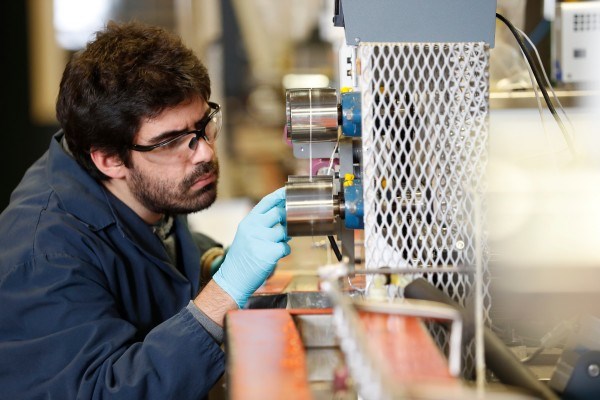University of Kentucky, ORNL partner to turn coal into high-value carbon fiber
The $10 million research partnership will focus on creating energy-efficient and cost-effective processes for the manufacturing of carbon fiber.

Ruben Sarabia-Riquelme, research engineer at the University of Kentucky Center for Applied Energy Research, works with a carbon fiber spinline. Source | Mark Mahan
It was reported on August 20 that the University of Kentucky Center for Applied Energy Research (UK CAER; Lexington, Ky., U.S.) and the U.S. Department of Energy’s (DOE) Oak Ridge National Laboratory (ORNL; Oak Ridge, Tenn., U.S.) are teaming up on a $10 million project to transform coal into high-value carbon fibers and composites. The project was funded by the DOE’s Office of Fossil Energy, and the collaboration will allow both organizations to maximize their respective expertise in the field.
According to UK CAER, the project, titled “C4WARD: Coal Conversion for Carbon Fibers and Composites,” seeks to develop the fundamental and translational science and engineering necessary to create energy-efficient and cost-effective processes for manufacturing carbon fibers with tunable properties. It will address challenges associated with coal processing, variability in coal feedstocks and carbon fiber manufacturing scale up from laboratory to semi-production scale.
The university notes that coal-to-carbon fiber research shows great promise to positively impact the nation’s sluggish coal industry. In 2019, it is said that U.S. coal production, consumption and employment reached their lowest levels in 40 years. UK CAER says these trends are likely to persist as coal continues to lose market share to natural gas and renewable generation in the electric power sector. Recent studies suggest that U.S. coal utilization for coal-to-products applications has the potential to reach utilization levels on the same order of magnitude as that of steam coal.
Further, says the university, the market for carbon fibers, continues to grow, driven by increased use in aerospace and defense applications as well as lightweighting of automobiles. New market growth in other high-volume applications — such as thermal insulation for buildings and materials for construction and infrastructure — also show great promise. The market for carbon fibers is expected to grow at a compound annual growth rate of 12% through 2024.
CAER’s Materials Technologies Group, guided by director Rodney Andrews and associate director Matt Weisenberger, will lead the effort to convert a variety of coal feedstocks into carbon fibers and composites. Home to the largest carbon fiber spinline facility at any academic institution in North America, UK CAER says it will be working with ORNL to optimize coal-derived pitch processing for carbon fiber and composites development. CAER will produce laboratory-scale quantities of carbon fiber to develop structure-property relationships between the feed coal material and the resultant carbon fiber to develop processing-structure-properties relationships.
The university says ORNL will be leading efforts in materials characterization, technoeconomic analysis and technology-to-market portions of the project. More specifically, ORNL will be using its expertise in chemistry and high-performance computing to correlate the molecular structure of coal with its processability, identifying optimum pitch compositions to fabricate carbon fibers with tunable properties.
Additionally, CAER and ORNL will also collaborate to develop process conditions for scaling up fiber production at the Carbon Fiber Technology Facility (CFTF) at ORNL, DOE’s only designated user facility for carbon fiber innovation. The CFTF, a 42,000-square-foot facility, reportedly provides a platform for identifying high-potential, low-cost raw materials including textile, lignin, polymer and hydrocarbon-based precursors. Using the CFTF, ORNL is developing optimal mechanical properties for carbon fiber material, focusing on structure property and process optimization.
The facility is also said to be capable of custom unit operation configuration and has a capacity of up to 25 tons per year, allowing industry to validate conversion of its carbon fiber precursors at semi-production scale.
“Adding value to Kentucky and the nation’s economy has long been a hallmark of our research and outreach at the UK Center for Applied Energy Research,” Andrews says. “This coal-to-carbon fiber project allows us to continue that tradition in new and exciting ways and alongside a partner in Oak Ridge National Laboratory that is known across the globe for their innovation, discovery and technology transfer programs.”
Related Content
Overair's Butterfly eVTOL prototype to integrate composites-intensive design
Aiming for first flight tests in the latter half of 2023, Overair’s Butterfly aircraft uses Toray carbon fiber/epoxy prepreg strategically to cut weight on its battery-powered, quiet aircraft.
Read MoreZeroAvia advances to certify ZA600 in 2025, launch ZA2000 with liquid hydrogen in 2027
Lightweight composite tanks are key to ZeroAvia’s vision for H2 aircraft to rival range and utility of jet fuel aviation.
Read MoreSuCoHS project: Advancing composite solutions for parts with high thermal and mechanical loads
New materials, structural concepts and manufacturing using sensors for composites that resist fire, temperature and loads while providing weight and cost savings versus metals.
Read MoreJEC World 2023 highlights: Innovative prepregs, bio-resins, automation, business development
CW’s Jeff Sloan checks in with JEC innovations from Solvay, A&P, Nikkiso, Voith, Hexcel, KraussMaffei, FILL, Web Industries, Sicomin, Bakelite Synthetics, Westlake Epoxy and Reliance Industries.
Read MoreRead Next
From the CW Archives: The tale of the thermoplastic cryotank
In 2006, guest columnist Bob Hartunian related the story of his efforts two decades prior, while at McDonnell Douglas, to develop a thermoplastic composite crytank for hydrogen storage. He learned a lot of lessons.
Read MoreCW’s 2024 Top Shops survey offers new approach to benchmarking
Respondents that complete the survey by April 30, 2024, have the chance to be recognized as an honoree.
Read MoreComposites end markets: Energy (2024)
Composites are used widely in oil/gas, wind and other renewable energy applications. Despite market challenges, growth potential and innovation for composites continue.
Read More


















.jpg;maxWidth=300;quality=90)







